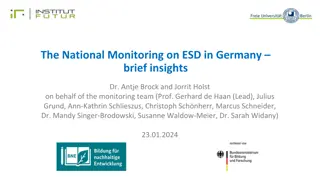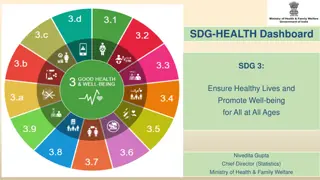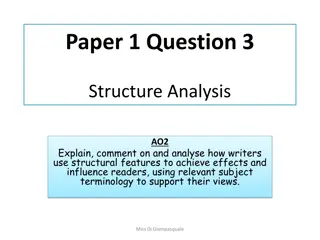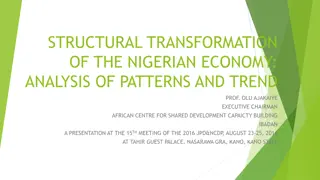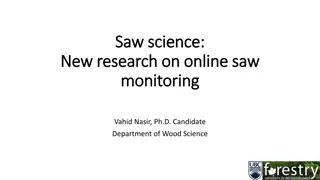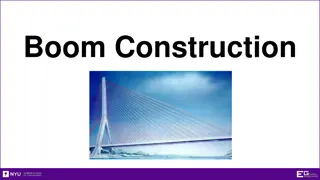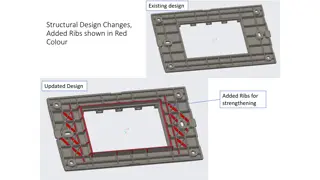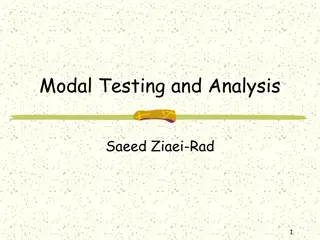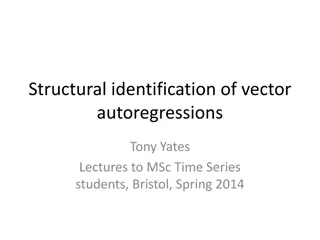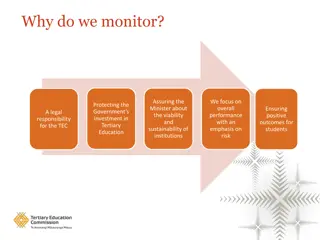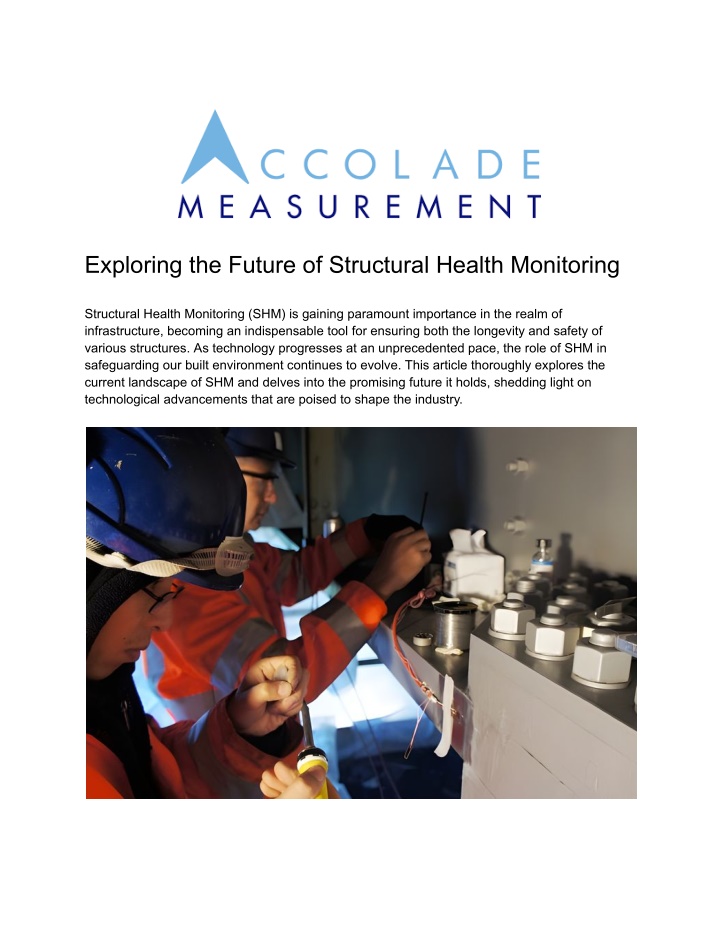
Exploring the Future of Structural Health Monitoring
Exploring the Future of Structural Health Monitoring
Download Presentation

Please find below an Image/Link to download the presentation.
The content on the website is provided AS IS for your information and personal use only. It may not be sold, licensed, or shared on other websites without obtaining consent from the author. If you encounter any issues during the download, it is possible that the publisher has removed the file from their server.
You are allowed to download the files provided on this website for personal or commercial use, subject to the condition that they are used lawfully. All files are the property of their respective owners.
The content on the website is provided AS IS for your information and personal use only. It may not be sold, licensed, or shared on other websites without obtaining consent from the author.
E N D
Presentation Transcript
Exploring the Future of Structural Health Monitoring Structural Health Monitoring (SHM) is gaining paramount importance in the realm of infrastructure, becoming an indispensable tool for ensuring both the longevity and safety of various structures. As technology progresses at an unprecedented pace, the role of SHM in safeguarding our built environment continues to evolve. This article thoroughly explores the current landscape of SHM and delves into the promising future it holds, shedding light on technological advancements that are poised to shape the industry.
SHM: Guardians of Infrastructure Integrity Structures, ranging from expansive bridges to towering buildings, endure dynamic forces that pose continuous threats to their integrity. Over time, these forces can lead to wear and tear, potentially compromising structural stability. By providing actual insights into the health of structures, SHM ensures public safety and contributes significantly to cost reduction in maintenance activities. Evolving Technologies in SHM Sensor Innovations Recent advancements in sensor technologies have revolutionized SHM. Smart sensors with enhanced accuracy and durability are now capable of providing real-time data on structural conditions. Integration with IoT The Internet of Things plays a crucial role in the evolution of SHM. Integration with IoT enables seamless communication between sensors and data analytics platforms, facilitating more efficient monitoring and analysis. Machine Learning Applications The integration of machine learning algorithms enhances SHM's predictive capabilities. By analyzing the data, these algorithms can identify patterns and predict potential structural issues before they escalate. Challenges and Opportunities Data Security: Safeguarding Sensitive Insights As SHM relies extensively on data collection and analysis, a critical challenge emerges in ensuring the security of sensitive information. The wealth of data generated from structural assessments requires robust protective measures. Innovations in encryption and secure communication protocols become paramount to fortify the confidentiality and integrity of the invaluable insights obtained through SHM. Standardization: Bridging Gaps for a Unified Future The absence of standardized protocols within the Structural Health Monitoring (SHM) landscape poses formidable challenges in terms of interoperability and data comparison. Collaborative efforts among industry stakeholders are imperative to establish universal standards. A unified framework will enhance the compatibility of diverse SHM systems and
streamline data interpretation, fostering a more cohesive and efficient approach to structural health assessment. Opportunities for Businesses: Pioneering Innovation In the dynamic landscape of SHM, opportunities abound for businesses to lead the way in providing cutting-edge solutions. Companies are positioned at the forefront, leveraging advanced technologies to contribute significantly to the growth and innovation in the field. As businesses continue to push the boundaries, they not only enhance their portfolios but also drive the evolution of SHM, shaping the future of structural monitoring and maintenance. Future Trends in SHM: Shaping Tomorrow's Infrastructure Landscape Autonomous Monitoring Systems The future of SHM holds the promise of witnessing the ascendancy of autonomous monitoring systems. These innovative systems are poised to revolutionize the field by independently assessing and reporting structural health. By minimizing human intervention, these autonomous systems enhance efficiency and provide a continuous, real-time assessment of structural integrity.
Advanced Materials: Smart Structures for Tomorrow Incorporating advanced materials with built-in sensing capabilities is set to be a transformative trend in SHM. These futuristic materials are designed to provide real-time feedback on structural health, enabling a proactive approach to maintenance. Integrating such materials into the fabric of structures will not only enhance monitoring capabilities but also contribute to the longevity and sustainability of infrastructures. Integration with Smart Cities: Synergizing Urban Development As cities metamorphose into innovative ecosystems, integrating SHM into urban planning becomes desirable and crucial. Smart cities are poised to leverage SHM data to optimize infrastructure development and ensure sustainability. The seamless integration of monitoring systems into the urban fabric will enable cities to respond dynamically to structural health insights. Conclusion Structural Health Monitoring (SHM) is on the verge of a transformative era, driven by technological advancements and an increasing awareness of its critical significance. Leading the charge in this evolution is Accolade Measurement, a pioneering force committed to reshaping the landscape of structural monitoring. Beyond conventional practices, our services
are designed to monitor structures and nurture them for enduring resilience. With a focus on innovation, we offer state-of-the-art sensor technologies, expert data analytics, and proactive maintenance solutions, ensuring that structures are not merely observed but actively fortified against potential vulnerabilities. Take the first step toward structural excellence and explore a future where your structures stand resilient against the tests of time.


